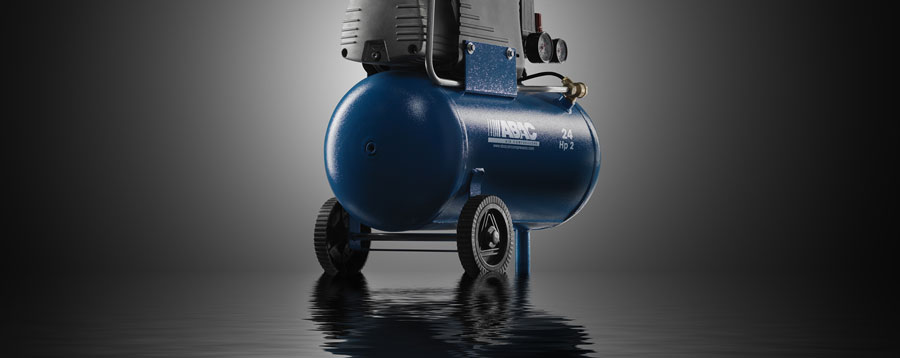
Which Air Compressor Do I Need?
Which air compressor do I need? This is one of the most frequently asked questions by people who want to start using pneumatic tools or air-powered machines. Whether you're a DIY enthusiast or a professional in the workshop: the right compressor makes all the difference in performance, efficiency, and durability.
To make the right choice, it's important to know what you'll use the compressor for, which air tools you want to connect, and how intensively you'll use it. In this blog article, we explain the different types of compressors, which specifications are important, and which compressor best suits your application.
What makes a good compressor?
A good compressor is one that fits your needs, delivers enough compressed air, and performs reliably. But what truly makes a compressor good?
- Enough air output (l/min): The more air your tool consumes, the higher the compressor's output must be.
- Correct tank size: For short tasks, a small tank (e.g., 6 to 24 liters) is sufficient. For continuous use, a larger tank (50 liters or more) is recommended.
- Oil-free or oil-lubricated: Using the compressor for a spray gun or applications where clean air is essential? Then go for an oil-free compressor.
- Noise level: Working indoors or in noise-sensitive environments? A silent compressor is ideal.
- Mobile or stationary: A mobile compressor is convenient on-site, while a stationary unit suits fixed workstations.
A good compressor perfectly matches your needs and the tools you’re using.
Compressor types and applications
There are different types of compressors, each with unique features and benefits. Below are the most common types:
- Oil-free compressor
- Silent compressor
- Mobile compressor
- 24-liter tank compressor
- 50-liter tank compressor
- 8 bar compressor
- 10 bar compressor
Oil-free compressor for clean air
These compressors are low-maintenance and produce clean, oil-free air. Ideal for paint spraying, blow guns, and applications where air purity is critical.
Silent compressor for noise-sensitive areas
Working indoors or in quiet environments? A silent compressor has a low noise level, making it more pleasant for you and those around you.
Mobile compressor for flexible use
A mobile compressor with wheels is perfect if you work at multiple locations or need to move it around easily.
24-liter tank compressor
Great for light to medium-duty jobs. This compressor offers a good balance between capacity and portability.
50-liter tank compressor
For more intensive or longer tasks, a 50-liter tank compressor is an excellent choice. Think of extended sanding, spraying, or grinding jobs.
8 or 10 bar compressor
Most air tools operate at 8 bar. For heavier tasks like sandblasting, a compressor with up to 10 bar may be needed.
Compressor for spray gun
For spray painting, an oil-free compressor is essential. It prevents paint contamination and ensures a smooth spray result.
Recommended features:
- Oil-free: avoids paint contamination
- Tank size of at least 24 liters
- Enough air output for your specific spray gun
(Note: HVLP spray guns require more air than LVLP models)
Check your spray gun’s specifications and match it with a suitable compressor.
Compressor for inflating tires
Inflating tires with a compressor is easy using a mini compressor or compact oil-lubricated compressor. Just connect a tire inflator and you're set.
- Ideal for bike, car, and scooter tires
- Use an oil-water separator to keep air clean
- For occasional use, a small compressor (6–24L) is more than enough
Compressor for sander
Air-powered sanding is efficient but requires a powerful compressor. A compressor for a pneumatic sander must provide enough airflow or the RPMs will drop.
- Minimum 24-liter tank for light tasks
- 50 liters or more for professional, long-term sanding
- Check the air consumption of your sander
Higher air output prevents interruptions while sanding.
Compressor for blow gun
A blow gun uses a lot of air to remove dust, dirt, or chips. You’ll need a compressor with:
- Sufficient air output
- Euro or Orion couplings for direct connection
- An oil and water separator to keep air lines clean
For light use, a compact compressor suffices. For heavy-duty work, go for a larger tank.
Which compressor for a nail gun?
A nail gun (or stapler) is a popular air tool for furniture building, finishing, or light woodworking. The right compressor ensures constant pressure for smooth operation.
Most nailers run fine on a compact, oil-free compressor with a 6–24 liter tank. Make sure to:
- Use 6–8 bar working pressure
- Check your nail gun’s air consumption (L/min)
- Use a pressure regulator to adjust output as needed
Working with a nailer on-site? A mobile compressor with a handle or wheels is a smart choice.
Compressor for sandblasting
Sandblasting requires high airflow and pressure. A compressor for sandblasting should have a large tank (at least 24 liters) to prevent constant cycling.
Key specifications:
- High airflow per minute (e.g. >300 l/min)
- Working pressure between 8 and 10 bar
- Stable and continuous air supply
Always use a proper oil and water separator to prevent clogs or moisture in the lines.
Which compressor to buy? Try our Selection Guide
After reading this article, you’ll have a better idea of which compressor suits your needs. Think carefully about:
- The tools you’ll be using
- How often and intensely you’ll work
- Your preferences regarding noise, mobility, and maintenance
Questions or need tailored advice? Our product specialists are happy to help you choose the right compressor. You can also use our Selection Guide – with just a few simple questions, you'll know which model is right for you!
Explore our full range on NonPaints.com – not only compressors, but also accessories like air hoses, regulators, and oil-water separators.





